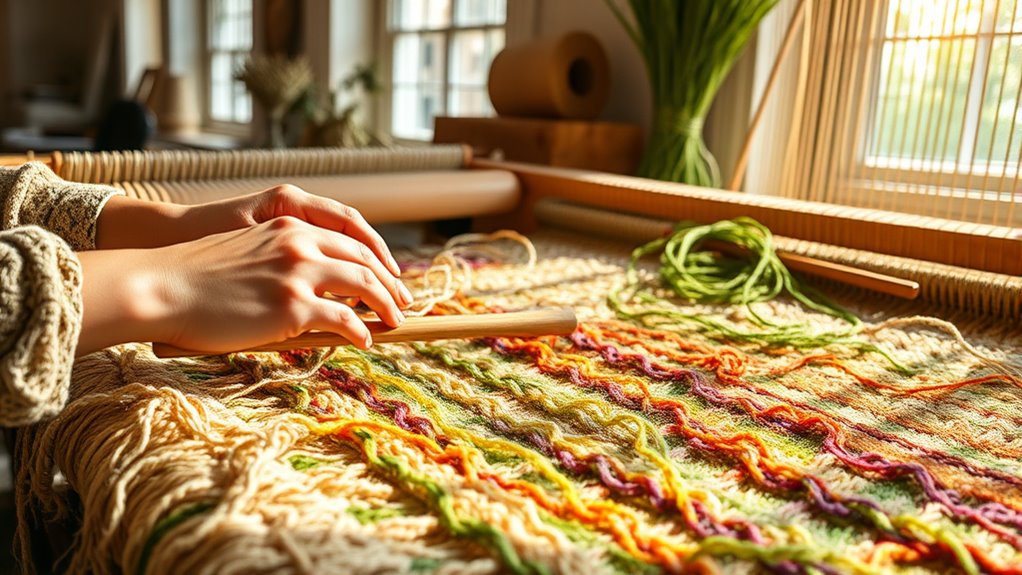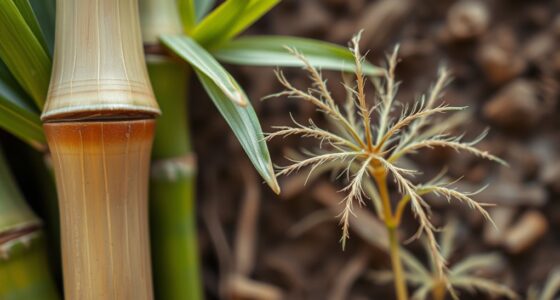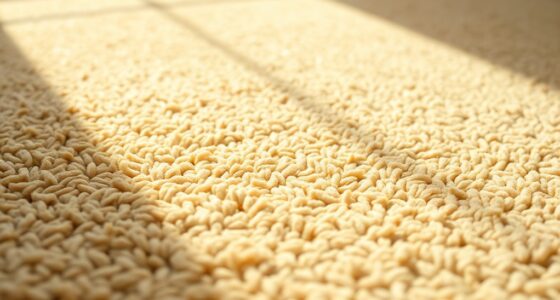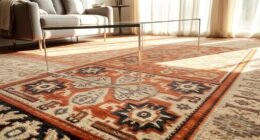Hemp plays a vital role in sustainable rug weaving by providing a natural, renewable material that’s both durable and eco-friendly. It grows quickly, requiring minimal water and no pesticides, helping reduce environmental impact. Hemp fibers are naturally resistant to pests and need fewer chemical treatments, making the rugs healthier and longer-lasting. Combining traditional craftsmanship with eco-conscious practices, hemp rugs support sustainable design and cultural heritage. Keep exploring to discover more about how hemp’s environmental benefits shape eco-friendly weaving.
Key Takeaways
- Hemp’s rapid growth and minimal resource needs make it an eco-friendly choice for sustainable rug production.
- Traditional weaving techniques with hemp preserve cultural heritage while reducing energy consumption.
- Hemp fibers’ natural resistance and antimicrobial properties enhance rug durability and reduce chemical treatments.
- Cultivating hemp supports soil health, prevents erosion, and lowers the environmental impact of textile manufacturing.
- Combining hemp with eco-conscious practices creates aesthetically appealing, durable rugs that promote sustainability.
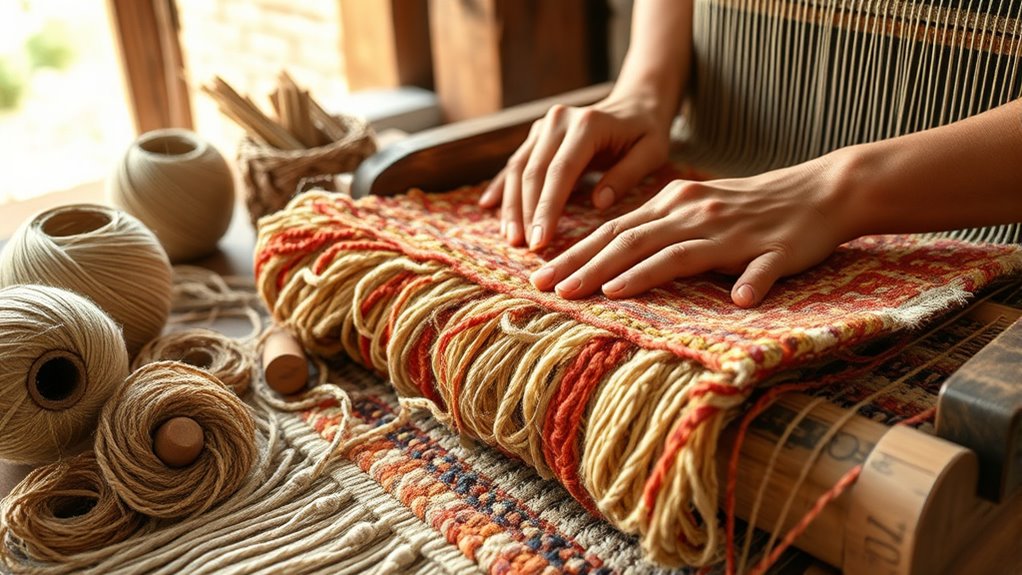
Hemp has emerged as a sustainable choice for rug weaving, offering an eco-friendly alternative to traditional materials. When you choose hemp, you’re making a conscious decision to support environmentally beneficial practices. Hemp plants grow rapidly, require minimal water, and thrive without the need for pesticides or synthetic fertilizers. This makes hemp a highly renewable resource that considerably reduces the environmental impact associated with conventional rug materials like wool or synthetic fibers. Its cultivation helps preserve soil health, prevents erosion, and lowers your carbon footprint, aligning with a greener lifestyle. Additionally, hemp cultivation often involves low-impact farming methods that further minimize environmental disturbance.
Using hemp in rug weaving also brings you closer to traditional techniques that have been passed down through generations. These techniques often involve natural dyeing processes and manual craftsmanship, which complement hemp’s sustainability. You can appreciate the artistry involved in traditional rug weaving, where artisans carefully hand-twist and knot hemp fibers to create durable, beautiful rugs. This method not only preserves cultural heritage but also ensures each piece is unique, with minimal reliance on energy-intensive machinery. When you support these age-old practices, you’re helping to keep traditional craftsmanship alive while promoting sustainable production methods.
Incorporating hemp into your rugs also offers long-lasting benefits. Its inherent strength and resistance to pests make it a practical choice that requires fewer chemical treatments. This means you avoid exposing yourself and your environment to potentially harmful substances, further enhancing the ecological advantages. Hemp fibers are naturally antimicrobial, reducing the need for chemical preservatives, and their durability ensures your rug will stand the test of time. As a result, you contribute to reducing waste, since high-quality hemp rugs don’t need frequent replacement, and less waste ends up in landfills.
Moreover, hemp’s versatility in rug weaving allows artisans to adapt traditional designs with modern sustainability principles. You can find rugs that blend the beauty of traditional patterns with eco-conscious materials, creating a perfect harmony between history and environmental responsibility. This fusion supports local economies and sustains craftsmanship, making your purchase meaningful beyond aesthetics.
Frequently Asked Questions
How Does Hemp Compare to Cotton in Durability?
Hemp surpasses cotton in fiber strength and wear resistance, making it more durable for rug weaving. You’ll notice that hemp’s tougher fibers resist tearing and fraying over time, even with heavy foot traffic. Cotton, while softer, tends to wear out faster and isn’t as resilient. So, if you want a long-lasting, sustainable rug, hemp is the better choice due to its higher fiber strength and superior wear resistance.
What Are the Environmental Impacts of Hemp Cultivation?
Hemp cultivation benefits the environment by improving soil health through its deep roots, which reduce erosion and replenish nutrients. It also requires less water compared to traditional crops, aiding water conservation efforts. You’ll find that hemp’s fast growth cycle means less land use and fewer chemicals needed, making it a sustainable choice that minimizes environmental impacts. Overall, hemp cultivation supports healthier ecosystems and conserves essential resources.
Can Hemp Rugs Be Recycled or Repurposed?
Hemp rugs can definitely be recycled or repurposed, and it’s easier than you think! You can upcycle your hemp rug by hemp dyeing it with eco-friendly dyes or even restore it through hemp restoration techniques. These methods breathe new life into your rug, making it last longer and reducing waste. So, don’t toss it—transform it! Your hemp rug’s journey doesn’t end; it’s just getting a sustainable upgrade.
How Does Hemp Affect Indoor Air Quality?
Hemp improves indoor air quality by actively purifying the air and reducing allergens. Its natural fibers help filter out airborne pollutants, creating a healthier environment. When you choose hemp products, you benefit from allergen reduction, which can lessen respiratory issues and improve overall air quality. Hemp’s eco-friendly properties make it a smart choice for maintaining a cleaner, safer indoor space, enhancing your comfort and well-being.
Are Hemp Rugs Suitable for High-Traffic Areas?
Absolutely, hemp rugs handle hustle and bustle in high-traffic areas with ease. Their durability is driven by hemp dyeing techniques that enhance strength, while low-maintenance hemp fibers resist wear and tear. Regular vacuuming and spot cleaning keep them pristine, making them perfect for lively spaces. You’ll find their eco-friendly essence not only endures daily demands but also elevates your environment with sustainable style and solid sturdiness.
Conclusion
Just as the ancient loom wove stories through time, hemp weaves a future rooted in sustainability. By choosing hemp, you embrace a tradition of resilience and eco-consciousness, echoing the timeless wisdom of our ancestors who valued harmony with nature. Your decision to incorporate hemp into rug weaving isn’t just a trend; it’s a modern echo of the past’s sustainable spirit, reminding us that, like the fibers you choose, our planet’s future depends on mindful, enduring choices.
